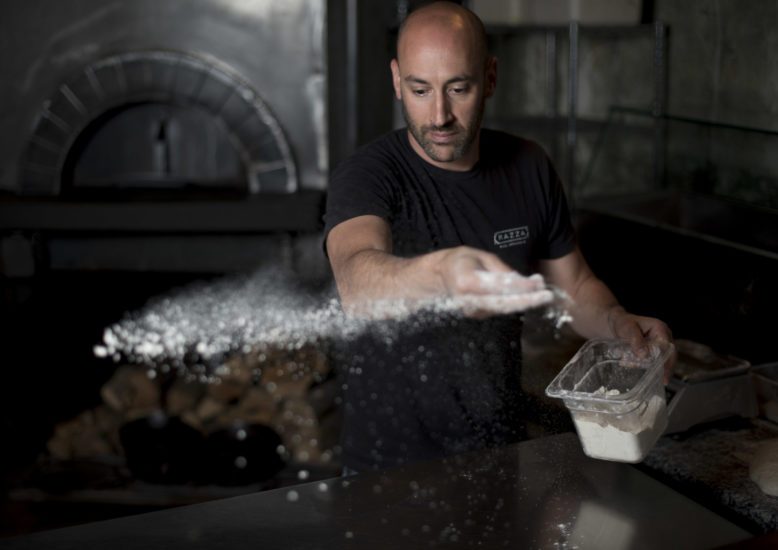
Tied to our March 2021 Pizza issue, dining editor Eric Levin caught up with Dan Richer, chef/owner of Razza in Jersey City, to chat about his memories of pizza and what goes into making the ideal pie. Read our guide to the best pizza in NJ here.
I started, like most kids in New Jersey, encountering pizza at birthday parties, schools functions, really everywhere. I grew up in Matawan. Central Jersey is lined with strip malls, and every one has a pizzeria, all doing relatively the same thing, though there are infinite small differences. Pizza is the first real food you can identify with, growing up in Jersey, and afford by yourself. Slices were a dollar when I was a kid. You gathered four quarters from under the couch cushions and you could buy yourself a slice.
Now, wherever I’m headed, on errands or to work or driving the kids to school, I know where I would stop for pizza. If I’m by the beach, I’m going to Rosie’s in Point Pleasant; on my way to Razza, there’s a place in Hazlet I like, Ray’s Real Pizza on Route 35. I also would recommend Rick Easton’s Bread and Salt in the Heights section of Jersey City. That guy is amazing. My favorite is his pizza rosa—it’s just dough, tomatoes, some olive oil and oregano. No cheese. It shines because he’s using the best products he can find and treating them simply and elegantly.
I went for lunch there recently. Standing in line outside I could smell the fermentation of the bread. The aroma was undeniably delicious. It’s ethereal.
My Ideal Pizza
I describe that in great detail in the book I’m writing. One of the ways I came up with it was to keep a running list that over the past 18 years or so has grown to over 40 characteristics. Because I was trying to create my ideal pizza, I needed a map to get to my destination. These include the aromas of fermentation in the crust, the way the cheese melts. Like, it should be fully melted with a little browning. But if you heat it too long it breaks and you get an oily puddle. Cheese is basically an emulsion of water and protein. If heated too long, it breaks down.
The sauce has to have right moisture content. If cooked too long it becomes thick and acidic and almost pasty. I like it velvety with a balance of moisture, sweetness and acidity. In the finished pizza I look for distinct areas of nicely melted cheese, distinct areas of sauce and then interconnected areas where cheese and sauce really marry together.
The dough should come out structurally sound. A slice in the hands should not fall apart, should not be soggy or wet. I like a really deep caramelization in the rim of the crust and want it to shatter when I bite into it. I do look at the undercarriage, the underside of the pizza, for deep caramelization there. I want to see if it was baked at the right temperature.
You can bake pizza at higher or lower temperatures, and it can come out alright, but you have to formulate the dough accordingly. In a home oven at 500 degrees, the dough has to be formulated differently from what you would do in a wood-fired oven at 700-to-800 degrees.
Dough fermentation is a super complicated topic I’ve been studying for a very long time. Pizza is a flatbread with condiments. So you have to study bread-making techniques in order to understand pizza. I spent a bunch of time in Naples, and I love the city, and they eat more pizza than anyone in the world. But they’re looking for different characteristics than I grew up loving. I don’t really love Neapolitan pizza, even in the city of Naples. There are places I can appreciate, but I want to make pizzas I love, pizza that’s crispy and shareable and so hot it can burn the roof of your mouth.
Another consideration is cheese—what kind, do you grate it, slice it, what size? All of that impacts how fast or slow it melts. We use multiple types of mozzarella. My favorite is from Sussex County, a dairy called Hillcrest Dairy where my friend Sal makes incredible mozzarella right next to where the cows are grazing. Think about how many hundreds and thousands of cheeses there are in the world. They all come from the same raw material. It’s fascinating to me.
As for toppings, I’m definitely a purist. The Margherita, essentially a plain pie, is always my apples-to-apples comparison, what I go for typically. In terms of toppings, there’s tradition and then there’s creativity. I like to toe the line between the two.
Pepperoni is arguably America’s favorite topping. I taste 12 or 13 different ones before I decide which I’m going to use. At Razza we use one from Vermont that is obscenely expensive. You have to slice each round on a deli slicer, it’s not pre-sliced. It’s got no antibiotics, hormones, nitrates, nitrites. I’m comfortable serving it to guests.
